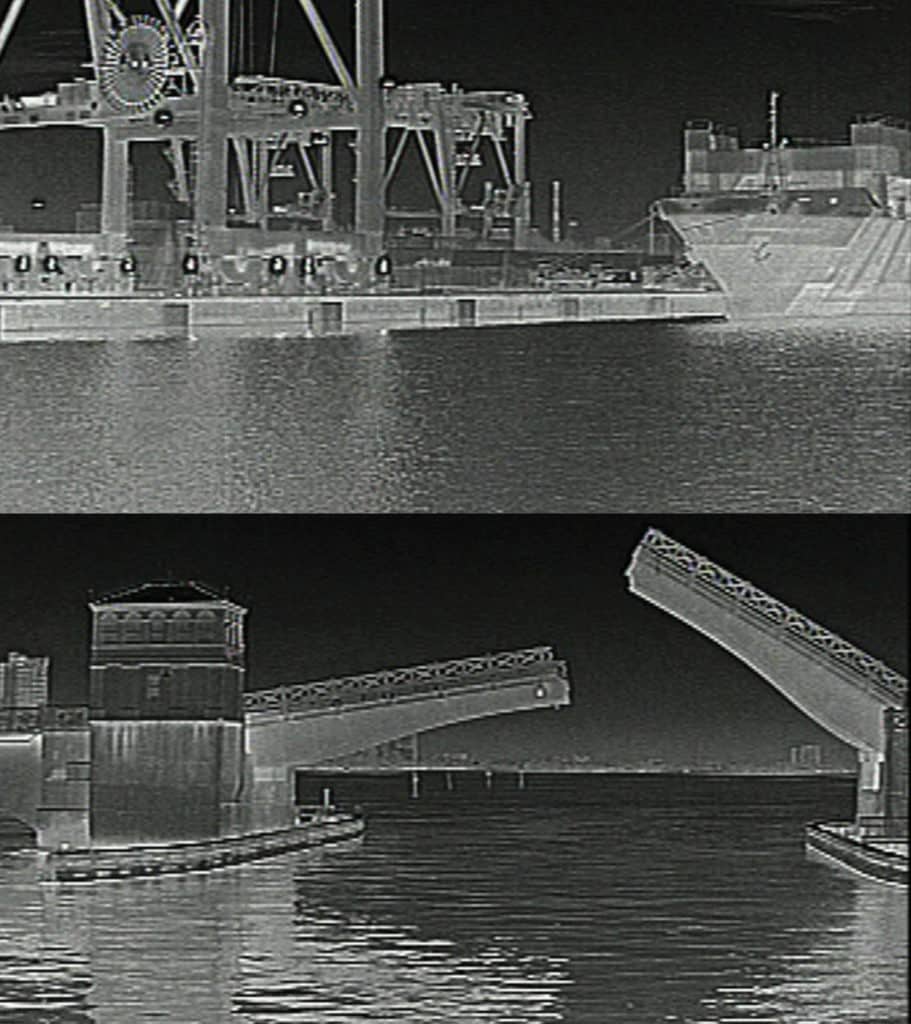
While modern boaters enjoy rarefied technology, our access to top products doesn’t insulate us from occasional high-tech hiccups. Take my experience at the 2016 Fort Lauderdale International Boat Show, where I spied the USS Zumwalt, the U.S. Navy’s newest and stealthiest guided missile destroyer, conducting tests just offshore. I pulled out my iPhone and rifled off some images using its 5x digital zoom. In my photos, however, Zumwalt resembled nothing more than an odd-looking horizon ornament; zoomed in tightly, she became a pixelated gray blob, not a mighty warship or even a social-media-worthy share. Rather than using true optical zooms, smartphone cameras use digital zooms that enlarge each pixel to blow up an area of interest. Most thermal-imaging cameras also use digital zooms to manage cost and size, which places a premium on the camera’s image sensor and the number of pixels it captures per frame (greater pixel counts mean better resolution and long-range performance).

While earlier-generation, fixed-mount thermal-imaging cameras worked exceptionally well at short and medium distances, their image sensors and digital (and/or restricted optical) zooms limited their ability to spot objects and vessels at great distances — drawbacks that FLIR solves with its new M500. The camera’s cryogenically cooled thermal core plus 1x to 14x continuous optical zoom coupled with a 4x digital zoom deliver stunning image sensitivity across all ranges.
Unlike Hollywood-style “night vision,” thermal-imaging cameras deliver crisp, black-and-white or color-rendered video imagery by using microbolometer sensors that detect minute thermal differences between an object and its background, provided that things are toastier than absolute zero (minus 459.67 degrees Fahrenheit). Critically, thermal-imaging cameras don’t rely on ambient or projected light, so they work equally well at all hours.
The M500 ($180,000) delivers a payload trifecta: a 640 x 512 camera that senses thermal differences of less than 30 millikelvins or (ballpark) 1/18 of a degree Fahrenheit; a separate 1920 x 1080 high-definition color daylight camera with a 30x optical zoom and a 12x digital zoom; and, finally, a high-intensity, narrow-beam LED spotlight. That spotlight is “great for [showing] people who aren’t operating the camera what it’s looking at,” says Jim McGowan, FLIR’s marketing manager for the Americas, adding that the spot’s tight beam helps ensure that it won’t interfere with anyone’s night vision.
The M500’s price tag springs from its Neutrino core. It delivers stunning resolution thanks to its cryogenic-cooling system, which pumps cooled helium into the thermal core’s receptors. “When we cool the thermal sensor, we significantly heighten its level of sensitivity,” McGowan says. “This allows the camera to see more temperatures, which it can measure at longer ranges.”

As a result, the M500 can detect a man overboard from 4.9 nautical miles and a small vessel from a gobsmacking 8.3 nautical miles — ranges unheard of for uncooled cameras. (FLIR’s $75,000 M400 can spot a man overboard at 1.3 nautical miles and a small vessel at up to 3.2 nautical miles.)
To prevent users from getting motion sickness, the M500’s gyrostabilized chassis dampens (or removes) vessel motion. The camera’s black, gimbaled enclosure houses the M500’s triple payload and is sealed, waterproof and built from heat-sinking aluminum. Additionally, the M500’s window heaters ameliorate ice accumulation.
Softwarewise, the M500 sports radar and video-tracking capabilities that help with collision avoidance. Provided that a yacht carries a compatible radar networked to the vessel’s NMEA 0183 backbone — allowing the radar to share Tracked Target Messages (TTMs) — the M500 uses TTMs to track as many as 100 targets. Even so, five or fewer concurrent targets is a more realistic real-world number, McGowan says. Users can also set the M500 to follow their radar display’s cursor position.
Additionally, the M500’s video-tracking capabilities enable the camera to track user-designated targets continuously, sans outside instrumentation. “Video-tracking software isn’t identifying every object as a potential hazard,” says McGowan, adding that when users tap an on-screen target, the M500 enters missile-lock mode. “Users choose an object, and this drives the camera’s pan and tilt functions to follow the target.” Plus, such imagery can be recorded.
Given the functionality, a helmsman can use radar for macro-level navigation and collision avoidance while using the M500 to monitor the biggest threats.
Users interface with the M500 by way of its joystick or a networked multifunction display. Alternatively, the M500 has an internal Web server and IP-enabled controls, allowing users to control the camera with a mobile device via the FLIR Mobile app (iOS- and Android-friendly), so long as the camera and wireless device are Wi-Fi-networked. While earlier-generation thermal-imaging cameras used downstream black boxes to tackle some functionality, the M500 is self-contained and has just four pigtails: Ethernet, analog video, HD-SDI and NMEA 0183.
The ITAR Hurdle
While FLIR has long built high-end, cryogenically cooled thermal-imaging cameras, the units fell under International Traffic in Arms Regulations (ITAR), restricting vendors from selling military-grade equipment to commercial or private customers. With the M500, FLIR secured U.S. Department of Commerce approval for dual military-commercial use. Provided that an M500 is “installed and used as expected,” says Jay-Robinson, FLIR Maritime’s vice president of product management, yachtsmen “can take it around the world without ITAR.”
As previously mentioned, the M500’s thermal-imaging camera has a 1x to 14x continuous optical zoom, plus a 4x electronic zoom. “At the end of its optical zoom, the camera automatically switches to its electronic zoom,” McGowan says. Once in e-zoom mode, the camera “starts cutting the pixels in half and stretching them. At each electronic zoom level, the image becomes [blockier], but that’s after a 14x optical zoom.” Thus, the M500 can move from a wide-angle 28-degree-by-21-degree field of view to a narrow 2-degree-by-1.5-degree field of view.
While FLIR M500s have impressive capabilities, their price tag makes them destined for superyachts or military and first-responder vessels. But if you’re seeking the yachting industry’s most sophisticated thermal-imaging camera, your query just found its answer.









